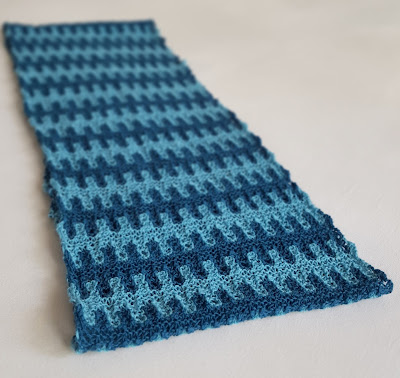 A cozy pair of slippers to warm your feet on a lazy afternoon at home. They also make great gifts for a loved one.
A cozy pair of slippers to warm your feet on a lazy afternoon at home. They also make great gifts for a loved one. The slippers are knitted from the toe up and without a seam. The sole is all in stockinette stitch while the upper part switches to garter stitch.
These slippers look best when knitted with some self-striping sock yarn.


This work by Knitting and so on is licensed under a Creative Commons Attribution-NonCommercial-ShareAlike 4.0 International License.
This pattern is also listed at AllFreeKnitting.com.
Materials
- about 40 to 50 grams of fingering weight yarn
- 3mm knitting needles (dpns or circular)
- three stitch markers
- a tapestry needle for grafting and to weave in ends
Techniques
- Cutting a sock template of your feet: To make the finished piece fit your feet, it is useful to measure your feet and to cut out a card template. Here's a blogpost at knitbettersocks.blogspot.com that explains the idea. For the heel as knitted here, make a mark at 5 cm from the end of the heel.If you want to knit a pair for someone else and cannot get a template, here are standard shoe size templates.
- Judy's Magic Cast-On is a technique that gives you live stitches on both sides of your needle - it is generally used for toe-up socks (e.g. in this pattern), but it can be used for other purposes as well. Here's a written description (from Knitty) and here's a YouTube-video by Cat Bordhi and another YouTube-video by Very Pink Knits.
- Central double decrease: as shown in this YouTube-video by Knit Purl Hunter.
- Garter stitch grafting: Here's a video by Knittinghelp.com that shows garter stitch grafting.
Instructions
 Make a cardboard template of your feet. Draw a line that marks half the length of your feet ("half line") - see picture on the right. The heel line will be drawn once you've finished knitting your toe.
Make a cardboard template of your feet. Draw a line that marks half the length of your feet ("half line") - see picture on the right. The heel line will be drawn once you've finished knitting your toe.Part 1 (Toe, worked in the round):
Magic CO 12 stitches per needle (your piece should look like illustration photo 1)
Knit one round and place one marker after 12 sts and another marker at the end of the round.
To get a shaped toe you first do 4 rounds with 4 increases each (around the markers). Then you alternate 1 neutral round (no increases) with 1 increase round (increases around the markers) twice. Then alternate 2 neutral rounds and 1 increase round - twice. Then alternate 3 neutral rounds and 1 increase round - and repeat this (3 neutral, 1 increase round) until the slipper is wide enough to fit your feet.
In order to mirror the increases in the toe, with decreases in the heel, I find that it helps to keep notes. I usually keep a tally: one normal tick for a neutral row, one squiggly line for an increase row.
Spelled out this means:
Round 0 (knitted directly after Magic CO): k12, place marker, k12, place marker
Round 1 (Increase round): kfb, k to 1 st before marker kfb, slip marker, kfb, k to last st, kfb
Rounds 2 - 4: Increase rounds (= round 1)
Round 5: k all stitches
Round 6: Increase round
Round 7: Neutral round (= round 5)
Round 8: Increase round
Round 9, 10: Neutral round
Round 11: Increase round
Round 12, 13: Neutral round
Round 14: Increase round
Round 15, 16, 17: Neutral round
Round 18: Increase round
Repeat Rounds 15-18 until the piece is wide enough to fit your foot.
After you've finished your toe - measure its length. Then draw a line on your template that's the same distance from the heel end. This line is called toe line on the picture above. Heel and toe will have the same length since the heel decreases will be exactly like the toe increases - backwards.
Depending on the yarn, I had 56 or 60 stitches in total on my needles.
Part 2 (worked in the round):
Knit rounds until your piece is long enough to reach the half line.
Leave the markers in, they will be needed later.
Part 3 (worked in rows):
Count the number of stitches on your needles. Divide by 4 and remember this number. (For 56 stitches, this number was 14 - for 60 stitches in total, it was 15.)
Row 0: Knit the calculated number of stitches, place a marker here ("end of row marker) and turn.
Row 1 (WS, inside): sl1, k to marker, p to marker, k to end of row marker and turn
Row 2 (RS, outside), sl1, k all (to end of row marker) and turn
Repeat rows 1 and 2 a total of 4 times
Row 9 (WS) = Row 1
Row 10 (RS), sl1, kfb, k to 2 sts before end, kfb, k1
Repeat rows 1 to 10 once more.
Repeat rows 1 and 2 until the piece is long enough to reach the heel line.
After a while you will see the end of row without the marker, so you can remove it.
 |
| Illustration Photos |
Part 4a (Heel, worked in rows):
To get a shaped heel you have to decrease the part between the markers the same way that the increases in part 1 were done on one side of the toe.
This means that you will alternate between one decrease row and 3 normal rows (just as many times as you did for the toe), then twice alternate between one decrease row and 2 normal rows, then alternate twice one decrease row and one normal row, and then knit only decrease rows until there are only 12 stitches between your markers.
A normal row is knitted as follows:
Normal Row (RS): sl1, k all
Normal Row (WS): sl1, k to marker, slip marker, p to marker, slip marker, k to end.
And a decrease row is knitted as follows
Decrease row (RS): sl1, k to marker, slip marker, ssk, k to 2 bef marker, k2tog, slip marker, k to end
Decrease row (WS): sl1, k to marker, slip marker, p2tog, p to 2 bef marker, p2togtbl, slip marker, k to end
Photo illustration 2 shows how the piece should look after a while.
Assuming that you knitted 18 rows for the toe, the heel would be knitted as follows:
R1 (RS, decrease row): sl1, k to marker, slip marker, ssk, k to 2 bef marker, k2tog, slip marker, k to end
R2 (WS, normal row): sl1, k to marker, slip marker, p to marker, slip marker, k to end.
R3 (RS, normal row): sl1, k to end
R4 (WS, normal row): sl1, k to marker, slip marker, p to marker, slip marker, k to end.
R5 (RS, decrease row): sl1, k to marker, slip marker, ssk, k to 2 bef marker, k2tog, slip marker, k to end
R6 (WS, normal row): sl1, k to marker, slip marker, p to marker, slip marker, k to end.
R7 (RS, normal row): sl1, k to end
R8 (WS, decrease row): sl1, k to marker, slip marker, p2tog, p to 2 bef marker, p2togtbl, slip marker, k to end
R9 (RS, normal row): sl1, k to end
R10 (WS, normal row): sl1, k to marker, slip marker, p to marker, slip marker, k to end.
R11 (RS, decrease row): sl1, k to marker, slip marker, ssk, k to 2 bef marker, k2tog, slip marker, k to end
R12 (WS, normal row): sl1, k to marker, slip marker, p to marker, slip marker, k to end.
R13 (RS, decrease row): sl1, k to marker, slip marker, ssk, k to 2 bef marker, k2tog, slip marker, k to end
R14 (WS, normal row): sl1, k to marker, slip marker, p to marker, slip marker, k to end.
R15 (RS, decrease row): sl1, k to marker, slip marker, ssk, k to 2 bef marker, k2tog, slip marker, k to end
R16 (WS. decrease row): sl1, k to marker, slip marker, p2tog, p to 2 bef marker, p2togtbl, slip marker, k to end
R17 (RS, decrease row): sl1, k to marker, slip marker, ssk, k to 2 bef marker, k2tog, slip marker, k to end
R18 (WS. decrease row): sl1, k to marker, slip marker, p2tog, p to 2 bef marker, p2togtbl, slip marker, k to end
Part 4b: Heel flap (worked in rows)
Now only one of the upper parts (in garter stitch) is worked, the stitches between the markers will be decreased row-by-row and the second garter stitch bit will not be worked until the kitchener stitch in the end.
Row 1: sl1, k to marker, ssk, turn, sl1, k to end
(Illustration photo 3 shows how the piece looks just before an ssk)
Repeat row 1 until there are only two stitches between the two markers
Then knit the following (last) row: sl1, k to 1 sts before marker, do a double central decrease
Illustration photo 4 shows how the piece should look just before the last row.
Now there should be the same number of stitches on both needles.
Graft in garter stitch.
Weave in ends.
Make two.
This blogpost was featured on Oombawkadesign Crochet's 144th Link and Share Wednesday. and at the New Tuesday PINspiration Link Party. Thank you!






























